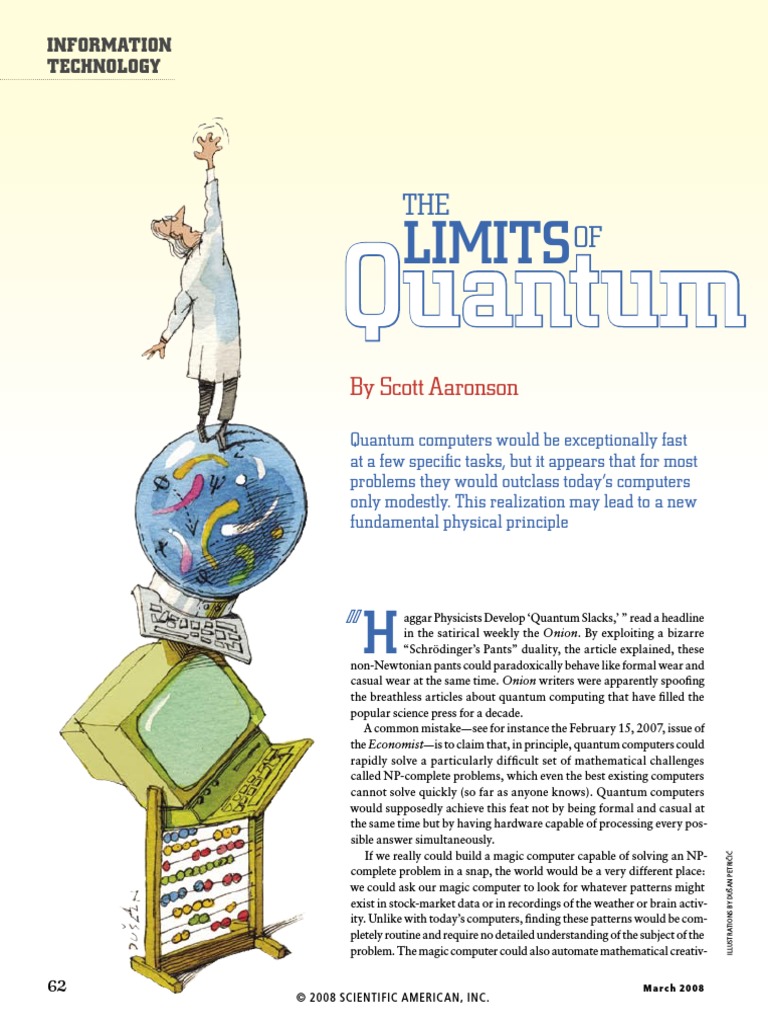Quantum computing is often heralded as a paradigm shift in computational efficiency and capability. However, beneath this promising surface lies a plethora of limitations that shape the applicability and feasibility of quantum systems. Understanding these limitations is crucial for both researchers and practitioners in the field. This discourse endeavors to elucidate the multifaceted restrictions inherent in quantum computing, providing an extensive examination of its theoretical and practical boundaries.
To appreciate the constraints of quantum computing, one must first consider the fundamental principles of quantum mechanics that it operates upon. Quantum bits, or qubits, exhibit superposition and entanglement, enabling computations that are ostensibly unattainable by classical systems. Yet, the very properties that render qubits powerful also engender significant limitations.
1. Decoherence: The Erosion of Quantum States
Decoherence stands as one of the most formidable challenges in quantum computing. It refers to the loss of coherence in quantum states due to interactions with the surrounding environment. As qubits interact with external factors—be it temperature, electromagnetic fields, or even cosmic radiation—their distinct quantum states can collapse into classical states, resulting in erroneous computations. Consequently, error rates increase, compromising reliability. Sophisticated error correction methods and techniques such as quantum error-correcting codes have emerged, yet they demand substantial resources, complicating the design of scalable quantum systems.
2. Limited Qubit Connectivity
Another salient limitation pertains to the architecture of quantum processors. Unlike classical bits, which can be manipulated and connected in elaborate ways within a classical circuit, qubits typically exhibit constrained connectivity. This limitation necessitates additional gate operations to perform entangled computations across distant qubits, increasing both time complexity and error rates. Quantum processors often rely on specific coupling methods or architectures, such as superconducting circuits or trapped ions, leading to design trade-offs that impact performance and versatility.
3. Quantum Algorithms and Their Domain-specific Efficacy
The promise of quantum computing is often encapsulated in the notion of quantum algorithms that outperform their classical counterparts. However, this advantage is not universally applicable. Quantum algorithms, such as Shor’s algorithm for integer factorization or Grover’s algorithm for unstructured search, exhibit super-polynomial speedup only for particular problem domains. For many classical problems, quantum algorithms do not offer significant advantages, thus limiting the practical application of quantum technology across diverse fields such as optimization, cryptography, and machine learning.
4. Scalability Challenges
The current landscape of quantum computing reveals significant scalability challenges. Present-day quantum computers are typically composed of a limited number of qubits, often in the range of dozens to a few hundred. The pursuit of building fault-tolerant quantum computers necessitates the integration of thousands, if not millions of qubits. Achieving this scale requires advancements in qubit manufacturing, error correction, and control systems, presenting a monumental engineering challenge. Moreover, as systems scale, the complexity of managing interactions and maintaining coherence increases exponentially.
5. Resource Intensity and Economic Viability
Quantum computing is inherently resource-intensive, particularly concerning energy consumption, materials, and infrastructure. This intensity poses questions about the economic viability of large-scale quantum systems. The costs associated with developing, maintaining, and operating quantum hardware can be prohibitive, particularly for smaller enterprises or research institutions. As a result, significant financial investment and strategic partnerships are pivotal for sustainable progress within the field.
6. The Quantum-to-Classical Transition
Upon obtaining results from a quantum computation, one encounters an inherent challenge in translating quantum outputs into classical information. The process of measurement collapses quantum states into determinable outcomes, often discarding potentially valuable information about the state prior to measurement. This transition from quantum to classical imposes a limitation on the amount of information that can be effectively mined from quantum systems, raising concerns regarding the interpretable utility of quantum results.
7. Quantum Supremacy: An Overstated Milestone
The notion of “quantum supremacy,” whereby quantum devices purportedly solve problems unverifiable by classical computers, has garnered considerable attention. However, this benchmark is often misinterpreted. The context and specific problem instances are crucial; the ability to achieve quantum supremacy does not equate to practical superiority across everyday computational tasks. It raises philosophical questions about the definition of computational power and highlights a limitation in understanding what breakthroughs truly entail in a practical sense.
8. Philosophical and Conceptual Boundaries
A deeper exploration into quantum computing also unearthed philosophical questions regarding the limits of computational theory itself. For instance, certain problems proved to be computationally irreducible, positing that even quantum systems cannot solve them in polynomial time. Furthermore, the early excitement surrounding quantum computing may overlook the reality that not all theoretically solvable problems are actually executable in practice due to intrinsic computational limits.
In conclusion, while quantum computing holds remarkable potential, it is indispensable to acknowledge its limits. From decoherence and connectivity issues to scalability and economic feasibility, the journey toward harnessing the full power of quantum systems is fraught with challenges. Recognition of these limitations not only fosters a more realistic perspective on quantum advancements but also guides future research directions to unlock the transformative capabilities of quantum technology judiciously. The path forward necessitates an amalgamation of theoretical insights, engineering prowess, and innovative ideation to chart a course through the complexities of this enthralling field.








